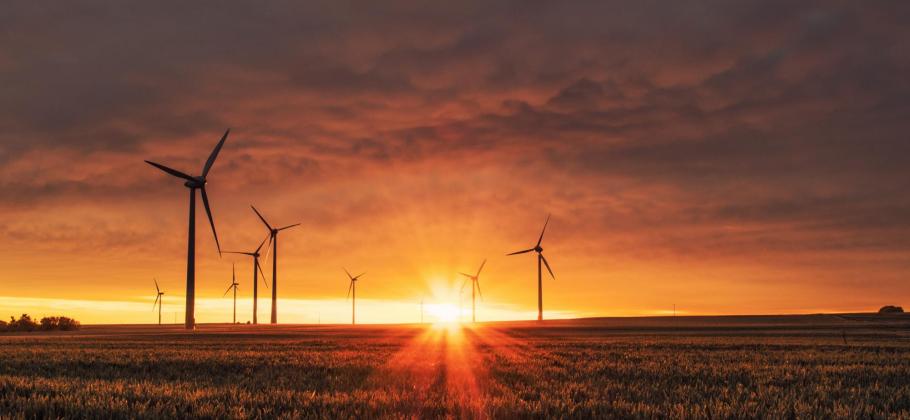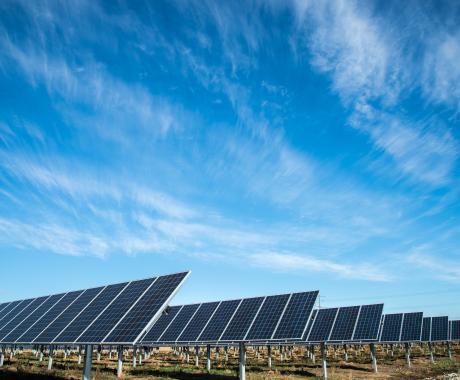Jul 2021
The guide to energy
We use it every day without even realizing it. At home, at the office, as transportation... energy provides a continuous service (or at least it should). But do we actually know how it's produced and which physical mechanisms are at work?

Defining energy
Whether it is with fuel, electricity or gas: an object needs enough energy to function properly. Mechanical or thermal processes create energy, but they also lead to wasted heat. The yield is the energy that remains. A large number of units are used to measure energy:
- The joule (J), a unit of the International System (IS)
- The kilowatt-hour (kWh), which is the most commonly used unit
- The calorie (cal), a unit used in nutrition
The conversion between each is as follows:
- 1 kWh = 3600 kJ
- 1 cal = 4.18 J
Primary energies
Primary energies exist in the natural world but they have to be transformed before they can be used. This is the case of the wind, the sun, water, biomass, geothermal energy, petroleum, coal, gas and uranium.
Primary energies are divided into two main families:
- mechanical energy (hydraulic, wind turbines)
- thermal energy (solar, or from fossil combustion as with oil, gas and coal)

Secondary energies
"Secondary energy" is obtained through the transformation of a
primary energy
For example, several primary energies are used to obtain electricity, the latter of which is a secondary energy. Solar energy passes through solar panels, nuclear energy needs reactors, hydraulic energy works with dams and the wind passes through wind turbines.
It is important to note that losses occur during the passage from a primary to secondary energy. These losses are due to the energy's transformation and transport.
Final energy
The final energy is the one that is available to the users. It differs from secondary energy due to the additional losses associated to transporting the secondary energy from the production site to the consumption site.
In France, for example, it is agreed that 1 kWh of final electrical energy is the equivalent to 2.58 kWh of primary energy.
Energy, a key issue in the energy transition
For decades, the important thing was to create energy and distribute it. Today, the stakes are reversed and we must adapt. Meeting demand is still essential, but there is an added need to decrease the use of fossil fuels and to gradually switch to renewable energies: wind, solar, biomass, hydraulic, biofuels, geothermal energy.
The combustion of fossil fuels is also a key environmental issue since it generates more than 60% of greenhouse gases.
In order to limit energy losses and to reduce the primary energy to final energy ratio, energy must be produced as locally as possible, close to the final consumers.
Energy recovery
Recovered energy is a renewable energy that isn't widely known but which is nevertheless used often. It involves capturing the heat (called “fatal heat”) emitted by different industrial practices to meet other needs.
A company can use the heat it produces for other purposes: to heat its buildings or for other purely industrial purposes. To do that, it needs to install devices such as heat exchangers. Thanks to heat networks, the heat can also be transported outside and serve other buildings. This recovered energy can also generate electricity[1].
The energy performance of buildings at the forefront
Residential and tertiary-sector buildings represent the largest share of energy consumption (40%). The French tertiary sector decree, which was published in 2019, requires certain buildings to lower their consumption by 40% (as compared to 2010) by 2030, and then by 50% by 2040 and by 60% by 2050.
Large companies with more than 250 employees are required to do an energy audit every 4 years. The ISO 50001 certification also exists to concretely and continuously help structures reduce their consumption. Companies with the ISO 50001 certification are exempt from the mandatory audit.
But how can companies and public organisations, whatever their size, take all the necessary steps to control their consumption?
They must choose a service provider that responds to their specificities and to the means at their disposal for energy management. Datanumia offers three different packages with options to conduct custom audits and to monitor consumption continuously:
• So Digital
With So Digital, you get a fully digital audit. It's the perfect introduction to energy management. It is a cost-effective solution that doesn't involve on-site disturbances since algorithms determine the consumption and usage of the building. Your company then receives a full report with recommended ways to reduce the building's consumption.
• So Agile
So Agile is a certified solution for those who are required to do an energy audit (EN NF 16247). It is also a flexible solution for all companies and communities wanting to manage their energy differently or wishing to try an EMS (energy management system) approach.
• So Wize
SoWize is the complete 360° solution to audit, centralise, monitor and manage your energy and fluid data. A dashboard also alerts you in the case of leaks or consumption excesses. This tool is perfectly in synch with a CSR policy, especially when energy managers, who are experts in energy performance, are there to monitor the process.
L’énergie : un enjeu essentiel de la transition énergétique
Si, pendant des décennies, l’important était de créer de l’énergie et de la distribuer, aujourd’hui, l’enjeu est inversé et doit s’adapter. Il s’agit toujours de répondre à la demande, mais dans une optique d’utiliser moins d’énergies fossiles et de passer peu à peu aux énergies renouvelables : éolien, solaire, biomasse, hydraulique, biocarburants, géothermie.
La combustion des énergies fossiles est aussi un enjeu environnemental primordial puisqu’elle génère plus de 60% des gaz à effet de serre.
Afin de limiter les pertes d’énergie et ainsi réduire le rapport entre énergie primaire et énergie finale, il est aussi important de produire l’énergie au plus près des consommateurs finaux.
[1] Source : ADEME
Picture by Karsten Würth on Unsplash
Picture by American Public Power Association on Unsplash
L’énergie de récupération, qu’est-ce que c’est ?
Parmi les énergies renouvelables, il en existe une qui fait moins parler d’elle et qui est pourtant très utilisée : l’énergie de récupération. Il s’agit de capter la chaleur émise par différentes pratiques industrielles (appelée la « chaleur fatale ») pour répondre à d’autres besoins.
Ainsi une entreprise peut utiliser la chaleur que ses actions produisent à d’autres fins, comme le chauffage de ses bâtiments, ou dans d’autres buts purement industriels. Pour cela, elle a besoin d’installer des échangeurs thermiques par exemple. Grâce à des réseaux de chaleur, celle-ci peut aussi être transportée à l’extérieur et bénéficier à d’autres bâtiments. Cette énergie récupérée peut également générer de l’électricité. Elle contribue efficacement à la gestion durable de l'énergie.
Quel est le problème des performances énergétiques des bâtiments ?
Les bâtiments résidentiels et tertiaires représentent la plus grande part de consommation d’énergie (40%). Avec le décret tertiaire paru en 2019, les bâtiments concernés devront ainsi diminuer leur consommation, par rapport à 2010, de 40% d’ici 2030, puis 50% en 2040 et 60% en 2050.
Les grandes entreprises, de plus de 250 salariés notamment, ont quant à elles l’obligation de réaliser un audit énergétique tous les 4 ans. Il existe par ailleurs la certification ISO 50001 qui, en plus de les aider concrètement et en continu à baisser leur consommation, les exonère de l’audit obligatoire.
Mais comment Datanumia accompagne les entreprises, quelle que soit leur taille, ainsi que les collectivités, pour réaliser toutes les étapes nécessaires à une maîtrise de leur consommation ?
Pour y parvenir, il faut que ces entreprises ou collectivités aient fait le choix d’un prestataire qui réponde à leurs spécificités et aient réfléchis aux moyens qu’elles peuvent engager dans le management de leur énergie. Datanumia permet de réaliser un audit sur mesure et le suivi énergétique constant de la consommation au travers de trois offres :
- La Plateforme de management énergétique
Multi-fluide et multi-site, l’iBoard constitue un véritable tableau de bord de vos consommations énergétiques. Il vous accompagne dans l’atteinte de vos ambitions d’économies d’énergie et la réduction de l’empreinte carbone de vos bâtiments.
- L’Energy Management
Bénéficiez d’une approche humaine personnalisée pour analyser vos consommations d’énergie et identifier les actions pour améliorer l’efficacité énergétique de vos bâtiments.
- L’instrumentation et la maintenance
Combinez suivi énergétique avec des capteurs de confort vous permettant d’adresser vos objectifs de réduction de consommation d’énergie tout en améliorant le confort des occupants.
Last news



